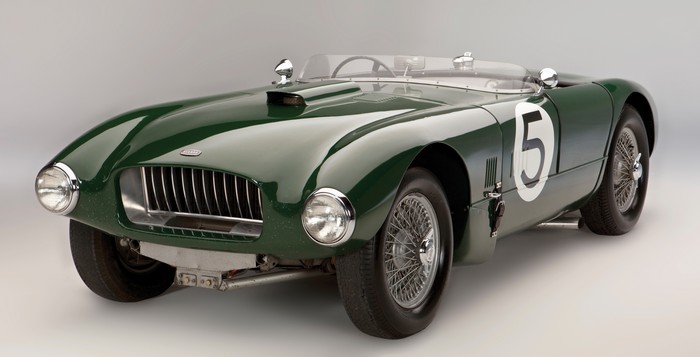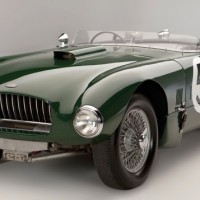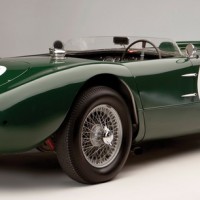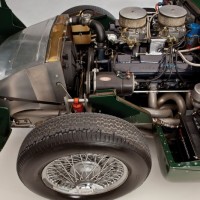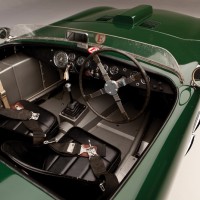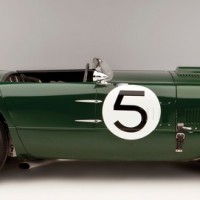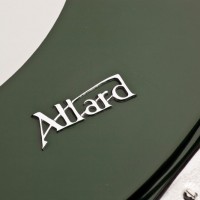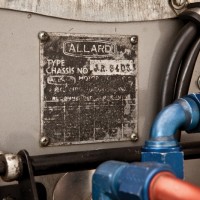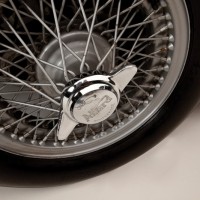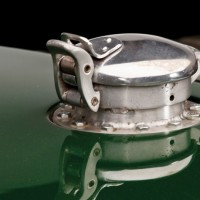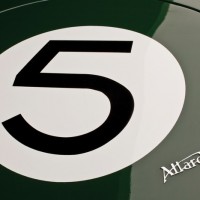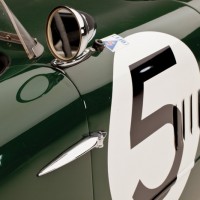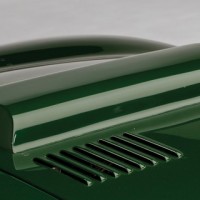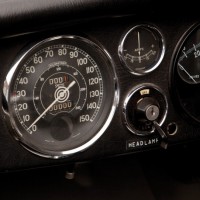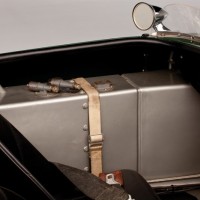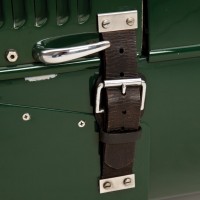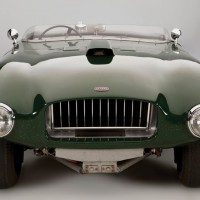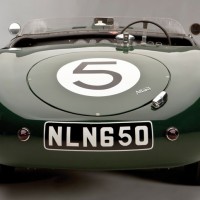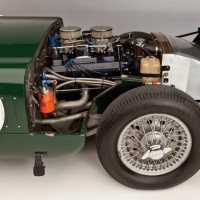• Estimated 350-hp, 365-ci Cadillac overhead valve V8 engine with dual four-barrel carburetors, 4-speed manual transmission, semi-independent front suspension with split axle, rear De Dion axle with coil springs and tubular shock absorbers, and Lockheed four-wheel hydraulic brakes
• One of only seven Allard JRs built
• One of two factory entries to the 24 Hours of Le Mans in 1953
• Driven 145.35 mph by Zora Arkus-Duntov down the Mulsanne Straight
Beautiful or brutal — take your choice — these Allards were the epitome of early 1950s sports-car design, with their slim alloy bodywork, cycle fenders, flashy knockoff mounted wire wheels and huge powerplants. Cornering at speed was a challenge as a result of Sydney Allard’s affection for a semi-independent front suspension.
Allard’s J2X cycle-fendered sports cars looked both brutal and beautiful, but Sydney knew they were aerodynamically disadvantaged on longer circuits such as Le Mans. Accordingly, the new envelope-bodied and streamlined JR model was introduced for 1953. These were essentially mechanically identical to the J2X, although seriously modified for circuit racing. Only seven JRs were built, with two cars serving as factory entries at the 1953 24 Hours of Le Mans.
SCM Analysis
Detailing
| Vehicle: | 1953 Allard JR Le Mans Roadster |
| Number Produced: | 7 |
| Original List Price: | $12,000 |
| Chassis Number Location: | Tag on frame, left side under headers |
| Engine Number Location: | Boss on left front of block |
| Club Info: | Allard Owners Club |
| Website: | http://www.allardownersclub.org |
This car, Lot 115, sold for $605,000, including buyer’s premium, at RM’s Arizona Auction on January 18, 2013.
This car also sold at RM’s Monterey auction in August 2007 for $341,000, and I wrote a profile of it then (November 2007 Race Profile, p. 62). This means that the guy who raised his paddle at Monterey got to enjoy a very rare Allard for about five and a half years while getting about a 12% annual return on his investment. Not too bad a deal, and it brings up a number of interesting speculations regarding the investment side of our hobby: Was he astute? Was he lucky? Are there lessons we can learn from the story?
The answer is probably yes to all of the above, and we will discuss that later, but first — for those who either missed or don’t remember the original profile — let’s do an Allard brush-up.
Allard history
Maybe the best way to start is to explain that the early 1950s were a time of major change in most aspects of automobile racing, and the cars of the era fell into two basic groups: the cars of the 1940s (really the concepts of the late 1930s) and the cars that presaged the modern era.
The cars of the first group tended to be simple and very robust to survive bad roads and tracks — and fundamentally reliant on horsepower to get things done. The best examples of this group are Allard, Talbot-Lago and Ferrari.
Second-groups cars included Jaguar (C-type), Aston Martin (DB3S) and Mercedes (W-194/300SL), and they were at the forefront of developing light, stiff chassis with relatively sophisticated suspension designs and conscious aerodynamics that introduced finesse and handling into the mix. They were the future.
Sydney Allard was a hot rodder of the old school, and his cars reflected it. He started out in the pre-war years in English Trials — sort of a wet motocross for cars — where he learned to appreciate strong frames and suspensions that couldn’t break.
In the early post-World War II years, he dabbled in hillclimbs, where he learned to appreciate cheap, reliable horsepower. These lessons were combined in the Allard production cars — both road and race versions — that valued strength over subtlety. As an amusing aside, construction aesthetics were overlooked as well: In my first “professional” restoration, a J2X, we discovered horrible welding splatter and even stuck welding-rod chunks still attached to the frame. When we pointed it out we were told, “No, don’t touch that stuff, it’s what proves that it’s a real Allard.”
The J Series cars
The Allard Company produced a wide variety of models based on a common mechanical package, but the pride of the lot were the racing-oriented sports cars: the “J” series.
The first J was basically a prototype, followed by the J2, which established the familiar cycle-fendered Allard profile. It was followed by the J2X, in which the frame was stretched and the engine moved forward seven inches — thus allowing Americans with legs to fit into the cockpit.
Allard did very well at Le Mans in 1952 but got into a problem in 1953 when the French organizers outlawed cycle fenders. In response, Allard used two approaches. The first, called the J2X LM, basically took a normal J2X and added an enormous single-piece bonnet to cover the front wheels. The second approach was to build an entirely new body on the shorter J2 chassis, which allowed a much smaller, more svelte and aerodynamic racer in the JR. The mechanical packages remained essentially identical among all of them.
A V8 guy
As to engines, the hot rodder in Sydney Allard far preferred the relative light weight and compact dimensions of a V8, but England didn’t produce anything worth using, so he incorporated American V8s into the design (virtually all of his cars were being exported to the United States anyway). First he used the Ford flathead V8, but in 1949 Cadillac produced what was basically the first “modern” V8 in their 331. It used newer casting techniques for light weight, five main bearings, and cutaway “slipper” skirts on the pistons to tightly clear the crankshaft, allowing a much more compact design. It made more torque and horsepower than its predecessor and weighed 200 pounds less. As soon as he could get his hands on them, they became the preferred power for Allards (Chrysler Hemis came along a few years later).
Remember that the mechanical package in all Allards is effectively the same, and that includes the front suspension. In his trials days, Allard learned to split a Ford solid front axle in half and pivot it in the center, which allowed the front wheels to move separately and was unbreakable (nice for muddy potholes) but didn’t really save any weight and created a truly appalling swing-axle front geometry (I recall being asked about the “crimes against nature” suspension design at Monterey Tech inspection one year).
On a smooth track it isn’t too bad, but on a bumpy road Allards can be a real handful: On an early Colorado Grand they closed a road for a timed speed run and I went through the trap in a J2 at 108 mph — which was 3,400 rpm. I didn’t dare go any faster on the narrow, crowned road. It was one of the scariest things I’ve done, and I drive racing cars all the time. Sydney liked the suspension, though, and it survived in virtually every Allard.
To recap, then, Allards are the classic example of the old-style racing cars of the early 1950s: simple, relatively flexible chassis with simple, relatively inflexible suspensions and insane amounts of horsepower for the weight. Whether they are fun to drive depends on your definition of fun, but they were — and remain — remarkably effective tools for the business of winning races. Finishing well (then or now) is very different from collector desirability now, and the racing Allards have never carried more than a fraction of the value of the far more user-friendly and comfortable C-type Jags and Astons of the era.
Very collectible, but not top tier
Allards, and particularly the JR, remain highly collectible, although they’re just on a lower plane than the heartthrob stuff. From an investment standpoint, which is the better place to be? A C-type in ’07 was worth about $3 million and is worth about $4 million now, which my calculator says is a 5.5% annual return, more or less. So, for the time between 2007 and 2013, the Allard did far better. It may be more complex than that, as different cars seem to appreciate in spurts: C-type Jags and Astons had a huge jump in value in the late 2000s, but they then more or less stalled. The Allard and second-tier cars may have had a similar but trailing spurt that matched the 2007–13 time slot better. No matter — the JR appears the more astute investment.
Too much discussion of investment qualities is not good, though. The most basic rule is to buy cars that you want and can afford because you love them, and I hope that approach was and remains the operative motivation for both the seller and the buyer of this JR. Nobody knows where the market is going to go: All we know is how much fun we can have along the way, and that is why we should be doing this. I’d suggest that this car was fairly bought and well sold. ?
(Introductory description courtesy of RM Auctions.)
